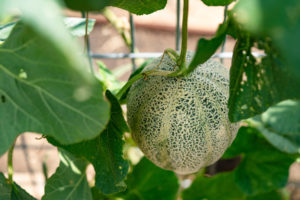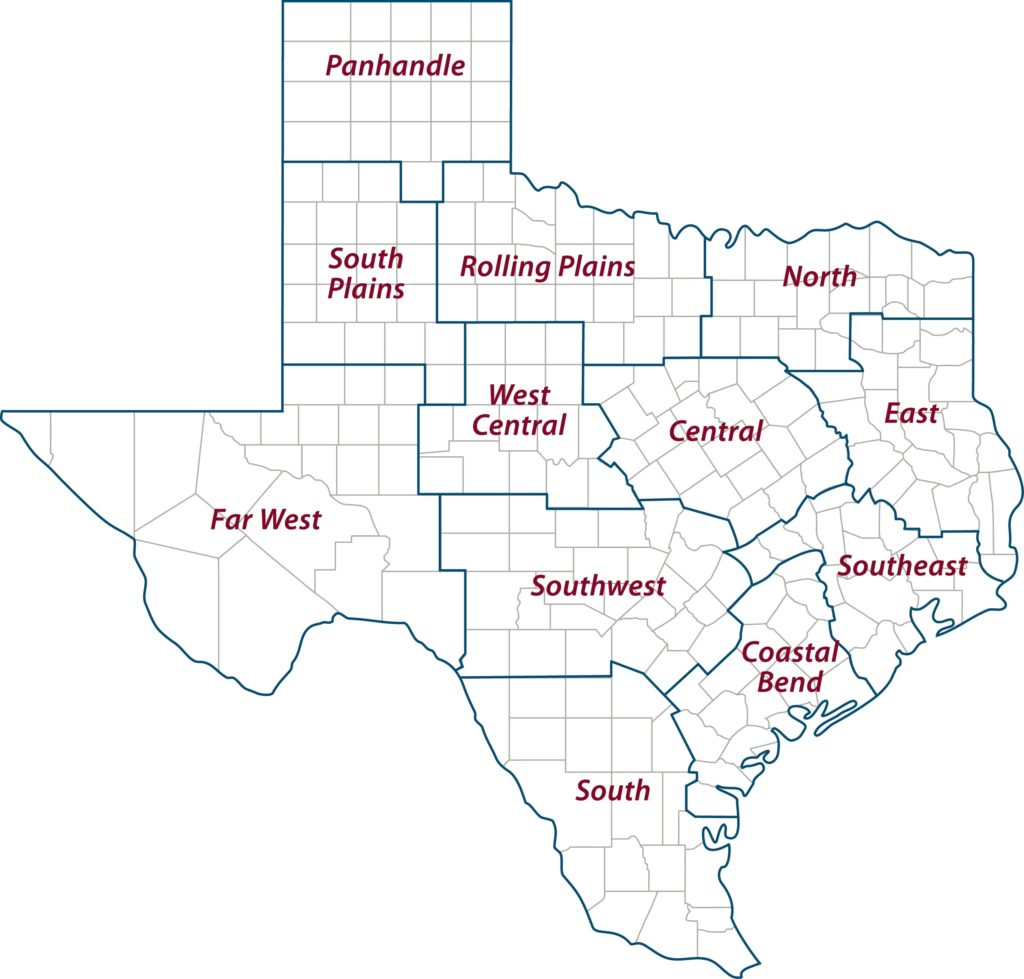Texas melon, cantaloupe quality up, yields down
Texas Crop and Weather Report – June 7, 2022
Texas melon producers reported exceptional fruit quality but slightly lower yields amid budget-breaking production costs and stagnant market prices, according to Texas A&M AgriLife Extension Service experts.

Watermelon production was coming to a close, and cantaloupe and honeydew harvests were well underway in the Rio Grande Valley. Watermelon and cantaloupe harvests were about to begin in the Winter Garden region as growers look to meet peak seasonal demand around the Fourth of July holiday.
Juan Anciso, Ph.D., AgriLife Extension horticulturist, Weslaco, said fruit sets were good and resulted in above-average yields and good quality, but that high temperatures were impacting new growth.
“The first cutting was heavy, and there is no new fruit coming on,” he said. “The plants seem to be shutting down.”
Despite good yields for watermelon producers, Anciso said honeydew melon growers experienced problems, including a hailstorm that hurt their fruit’s aesthetics. Fruit with cosmetic “nicks” were not marketable to grocers. In some cases, Anciso said around 50% of fields, representing thousands of pounds of melons, were deemed unmarketable.
“There has been a flood of melons with these flaws on street corners and fruit stands, but they really don’t make up for the losses when you are talking 18-wheelers full of melons that are considered culls,” he said. “Otherwise, growers in the Valley were looking at a heck of a season.”
Windy conditions, melons for Fourth of July
Larry Stein, Ph.D., AgriLife Extension horticulture specialist, Uvalde, said “desperately dry,” hot and windy conditions in Central Texas have contributed to slightly below-average watermelon and cantaloupe yields, but quality has been outstanding. Brix counts, the measurement for sugar content and sweetness, have been exceptionally high.
Cantaloupe producers have reported that the lack of rainfall and excess moisture has resulted in brix levels rivaling famed Pecos cantaloupes, Stein said.

Stein said fields with windbreaks were likely to fair better, as high winds negatively impact vine growth and their ability to bind to something and hold in place. High winds also blow vines together. The subsequent tangles of vines and windy conditions inhibit honeybees’ ability to pollinate blooms to set fruit.
High temperatures also impact the viability of pollen, he said.
“The heat and wind have been hard on melons this year,” he said. “The wind has been beating everything up, and it complicates pollination,” he said. “I think producers will hit the Fourth of July window, and the bottom line is that quality is exceptional despite the difficulties.”
Prices stagnant, costs increased for growers
Despite the good yields, Anciso and Stein said growers were less likely to realize profits due to flat prices and higher input and logistical costs. Costs for fertilizer, fuel, labor, packing materials and shipping all increased, but prices only increased slightly.
“Farms are getting 16 cents-18 cents per pound when we’d like to see them getting 20-plus-cents per pound,” Anciso said. “But growers are concerned about the high costs this season. The good yields should help offset costs for some, but it will be difficult to make money, and it’s not related to the supply and demand of their crop.”
Anciso said many melon harvests had been delayed by the lack of available harvest crews. Stein said costs had doubled for most producers and tripled for some.
“Costs are an issue for sure,” Stein said. “In some cases, producers will break even, maybe.”
AgriLife Extension district reporters compiled the following summaries:
CENTRAL
Some rainfall was reported. Temperatures were rising, and a string of 100-degree days, including a record high occurred. Drought conditions and heat were stressing pastures and crops. Soil moisture levels remained mostly short. Corn was filling, and cotton was improving somewhat if producers treated flea hopper infestations. Harvesting of oats and wheat was near completion but put on hold due to rains. Some hay was baled. Stock tanks were extremely low, and runoff water was needed. Livestock were in fair to good condition.
ROLLING PLAINS
A very beneficial storm system delivered 1-8 inches of rainfall. A little hail was reported. Wheat harvest was close to complete with 7-40 bushels per acre reported on dryland acres and 30-50 bushels per acre from irrigated fields. Corn and sorghum looked very good and should respond well to the moisture. Sudan and hay grazer fields looked good, though some fields were short and starting to head out. Producers need those fields to dry some before they can begin cutting and baling. Cotton planting was behind schedule but should gain speed after the recent rains. Pastures greened up after the rains. Supplemental feeding of livestock should decline. Rainfall also helped replenish water tanks. Coastal Bermuda grass fields looked good, and the first cutting made decent bales.
COASTAL BEND
Conditions were hot and mostly dry. Most crops were drought stressed and in poor to fair condition. Farmers continued to irrigate cotton where available. Some cotton stands were squaring and blooming despite the lack of moisture. Chinch bugs were reported in organic rice. Pasture and hay fields were in poor condition. Some hay was being harvested with less than desirable yields reported. Some producers were practicing rotational grazing, but most were feeding hay and supplements. Cattle prices remained high.
EAST
Very little rain fell across the district. Drought conditions slowed forage growth. Hay production continued with many producers harvesting their first cuttings. Pasture and rangeland conditions were fair to good. Subsoil and topsoil conditions were short. Fertilizer prices remained high. Some producers began to cull beef cattle herds due to rising input costs. Livestock were in fair to good condition. Armyworms were reported in Sabine County.
SOUTH PLAINS
Subsoil and Topsoil moisture levels improved. Producers were actively planting following recent rainfall. The rain and cooler temperatures helped with fire dangers and recently planted cotton. Cattle reported in good condition.
PANHANDLE
Overall, soil moisture levels were very short to short. Scattered showers and cooler temperatures were reported. Light precipitation up to 4 inches of rainfall was reported. Sorghums and other forages were being planted for grain, hay and silage cropping. Winter wheat was maturing, but yield potential looked below average. Cotton planting was wrapping up with just some dryland acres still unplanted. Much more rain will be needed to help summer crops and rangeland. Overall crop, rangeland and pasture conditions remained very poor to poor.
NORTH
Several rain events brought needed precipitation ranging from 1.5-6 inches across the district. Soil moisture levels ranged from short to surplus. The rainfall should encourage crop and forage growth. Wheat harvest was in full swing until the rains. Early reports indicate a good harvest for some areas. Corn was doing very well. Soybeans planted early looked great. Cotton was planted. Most producers had worked cattle for spring parasite control and vaccinations. Fly populations were very high due to the warm weather and recent rains. Tick populations were slowly increasing. Chigger populations exploded with the recent weather. Pasture and rangeland conditions were good to excellent.
FAR WEST
Temperatures ranged from the 90s to 100 degrees during the day with nighttime temperatures in the 60s to 70s. Severe weather including wind, rain and nickel-sized hail was reported. Rain accumulation ranged from trace amounts to 0.4 of an inch. Rainfall should improve forage on rangeland and pastures, but very few cattle remained in the district. No dryland cotton had emerged so far. Irrigated cotton was emerging slowly, and the rain should help. Watermelons and pecans looked good. Some pecan orchards were sprayed for pecan nut casebearer. Alfalfa fields were faring well under limited irrigation. Hay grazer was up but not faring well. Producers finished working lambs and kid goats.
WEST CENTRAL
A thunderstorm brought cooler temperatures and much-needed moisture. Pastures and forages greened up and started growing again. Most stock tanks caught a little water, but much more was needed to replenish them. Cotton planting continued, and wheat harvest was underway, though very few acres were being harvested for grain. Supplemental feeding of livestock continued. Livestock producers continued to cull animals.
SOUTHEAST
Areas of the district received trace amounts up to 1 inch of rainfall. Producers were fertilizing rice and cutting and baling hay. Some pastures continued to decline while others were responding to recent rains with ratings ranging from very poor to excellent. Suppliers noted around 60% of typical fertilizer purchases, and hay prices were increasing. Livestock were in good condition. Warm-season vegetables were producing, and farmers markets were opening. Cotton and corn looked good.
SOUTHWEST
Hot, dry and windy conditions continued and remained in the forecast. Corn and sorghum continued to decline due to hot temperatures and lack of moisture. Fruit tree yields looked very poor. Wheat and oat harvests were completed. Non-irrigated crops continued to suffer. Hay fields were in good condition, though irrigated were better than dryland. Herbicide and fertilizer applications were delayed in many instances due to dry conditions. Rangeland and pasture conditions remained poor. Some cattle producers were culling their herds. Fawning started as white-tailed does were starting to be seen with babies. Supplemental feeding of livestock continued. Rain was needed.
SOUTH
Soil moisture levels ranged from very short to adequate. Temperatures reached into the triple-digits. Some producers reported fields were drying down following excess moisture from recent rains. Peanut planting was in full swing, some fields continued to be prepared. Potato harvest was underway. Vegetable production slowed some due to extreme heat and drought. Cotton, corn and peanut conditions were excellent under irrigation. Watermelon, cantaloupe and forage fields continued to receive irrigation. Recent rains helped citrus growers reduce irrigation. Corn and sorghum continued to progress. Around 5,000 acres of corn, grain sorghum, sesame and sunflowers were destroyed by last week’s hailstorm. Cotton fields were squaring to setting bolls on lower parts of plants. Agents reported flea hopper pressure in cotton. Chili thrip pressure was increasing in cotton as well, but spider mite pressure declined following recent rains. Grain sorghum was flowering and experiencing light midge and armyworm pressure. But pest pressure was increasing in crops overall. Rangeland and pasture ratings continued to decline in drier areas, but areas that received recent rainfall reported some improvement. Some producers reported rapidly improving pasture and rangeland conditions with green, growing grasses. Beef cattle were still being fed hay in other areas, and there were reports of herd consolidations. Hay supplies were getting very short and feed input costs were driving deeper culling. Stock tanks were relatively full in most areas. Cattle markets were reporting below-average sale volumes and lower prices. Producers planted hay grazer.



